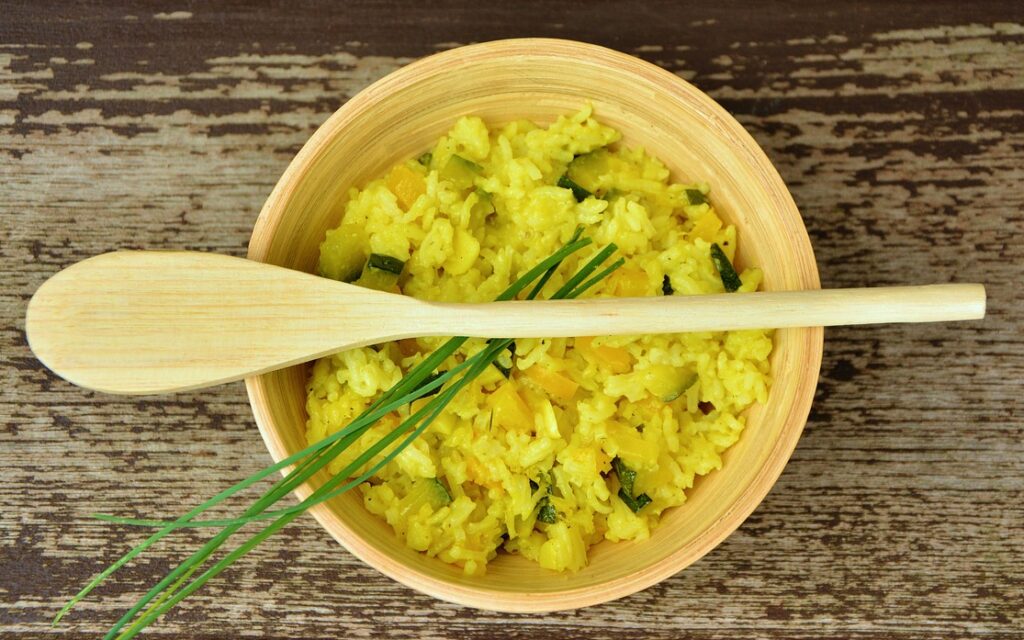This is a classic Italian rice dish cooked to creamy perfection.
It is a testament to the elegance of simplicity in cooking. Transforming humble ingredients into a dish that is both comforting and luxurious, risotto has earned its place as a beloved staple in Italian cuisine and beyond.

Skill Level: Intermediate
This recipe is for those with some basic cooking skills. It requires attention to detail, patience, and a bit of finesse to get the perfect creamy texture without overcooking the rice.
Healthy Aspects
Risotto is a good source of carbohydrates and, depending on your additions, can be enriched with vegetables for fiber and vitamins. Using low-sodium broth and moderate amounts of cheese makes it healthier.
Classic Rice Risotto Recipe
Time & Servings
- Prep time: 10 minutes
- Cooking time: 30 minutes
- Total time: 40 minutes
- Servings: 4
Ingredients
- Arborio rice: 8 ounces (227 grams) (See Arborio Substitutions)
- Low-sodium chicken or vegetable broth: 4 cups (960 ml)
- Olive oil: 2 tablespoons (30 ml)
- Finely chopped onion: 1 medium
- Dry white wine: 1/2 cup (120 ml)
- Freshly grated Parmesan cheese: 3 ounces (85 grams)
- Unsalted butter: 2 tablespoons (30 grams)
- Salt and pepper, to taste
- Fresh parsley, chopped for garnish
Step-by-Step Instructions
- Broth Preparation: In a saucepan, warm the broth over low heat.
- Sauté Onions: In a separate heavy-bottomed saucepan, heat the olive oil over medium heat. Add the onions and sauté until they are translucent.
- Toast Rice: Add the rice to the onions, stirring to coat with oil. Cook until the rice becomes a pale, golden color.
- Add Wine: Pour in the wine, stirring continuously until it has been fully absorbed by the rice.
- Cook the Risotto: Add 1/2 cup of warm broth to the rice and stir until the broth is absorbed. Continue adding the broth 1/2 cup at a time, waiting until the liquid is absorbed before adding more.
- Check Rice: Cook until the rice is al dente and the mixture is a creamy consistency, about 20 minutes.
- Final Touches: Remove from heat. Stir in butter and Parmesan cheese. Season with salt and pepper. Garnish with parsley.
Best Tips for Perfection
- Stir constantly to prevent sticking.
- Use warm broth to avoid reducing the cooking temperature.
- Avoid overcooking; risotto should be slightly al dente.
- Serve immediately as risotto continues to thicken off the heat.
Optional Ingredients
- Mushrooms, sautéed separately and added at the end.
- Saffron, for a classic Milanese risotto.
- Cooked seafood for a luxurious variant.
Serving Suggestions
Serve with a light salad, steamed vegetables, or enjoy as a stand-alone dish. Complement with a glass of crisp white wine.
Nutrient Information (per serving)
- Calories: Approximately 350-400
- Carbohydrates: 45-50g
- Protein: 10-15g
- Fat: 10-15g
Storing & Reheating Leftovers
- Storage: Store in an airtight container in the refrigerator for up to 3 days.
- Reheating: Add a little broth or water and reheat gently on the stove, stirring frequently.
Substitutes for Arborio for this Classic Rice Risotto Recipe
Yes, you can use other types of rice for risotto, though the results will vary from the traditional version which uses Arborio rice.
The key characteristic of a good risotto rice is its high starch content, which lends the dish its signature creamy texture. Here are some alternatives:
- Carnaroli Rice: Often called the ‘king of risotto rice,’ Carnaroli has a higher starch content and firmer texture than Arborio. It’s less likely to get mushy, making it a great choice for risotto.
- Vialone Nano: This is another Italian variety, shorter and rounder than Arborio. It’s particularly good for absorbing flavors and maintaining a creamy yet firm texture.
- Pearl Barley: While not a rice, pearl barley can be used for a risotto-like dish. It won’t be as creamy but offers a unique texture and nutty flavor, plus additional fiber.
- Brown Rice: For a healthier take, brown rice can be used. It has more fiber and nutrients but takes longer to cook and won’t be as creamy as traditional risotto rice.
- Sushi Rice: Sushi rice can be used as a substitute due to its stickiness, but it tends to be a bit too sticky for the creamy, loose consistency of a classic risotto.
When using these substitutes, be mindful that cooking times and liquid amounts may vary.
Additionally, the final texture will be different from a traditional risotto, but still delicious in its own right.
Here’s why…
(Learn about rice on Wikipedia.)
Origin and History
Interestingly, originating from Northern Italy, risotto’s history dates back to the 1800s. The introduction of rice to Italy in the Middle Ages led to the development of this unique cooking method, showcasing the versatility of rice.
The Good News
Whether you’re a risotto novice or a seasoned pro, this classic dish rewards with rich flavors and a luxurious texture. Perfect for a cozy dinner or a special occasion, risotto is a timeless dish that continues to delight palates around the world.